Scientists scale terahertz peaks in nanotubes
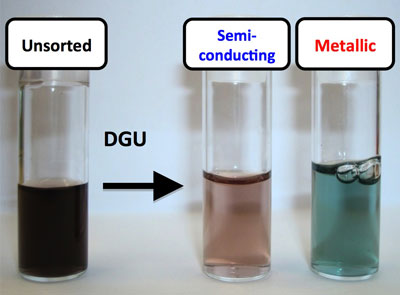 Researchers find plasmonic root of terahertz signals in some carbon nanotubes.
Researchers find plasmonic root of terahertz signals in some carbon nanotubes.
Dec 9th, 2013
Read more
 Researchers find plasmonic root of terahertz signals in some carbon nanotubes.
Researchers find plasmonic root of terahertz signals in some carbon nanotubes.
Dec 9th, 2013
Read more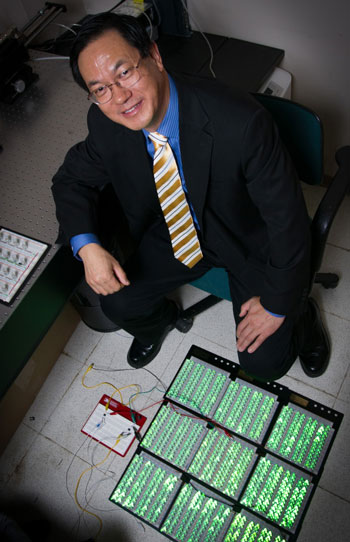 With one stomp of his foot, Zhong Lin Wang illuminates a thousand LED bulbs - with no batteries or power cord. The current comes from essentially the same source as that tiny spark that jumps from a fingertip to a doorknob when you walk across carpet on a cold, dry day. Wang and his research team have learned to harvest this power and put it to work.
With one stomp of his foot, Zhong Lin Wang illuminates a thousand LED bulbs - with no batteries or power cord. The current comes from essentially the same source as that tiny spark that jumps from a fingertip to a doorknob when you walk across carpet on a cold, dry day. Wang and his research team have learned to harvest this power and put it to work.
Dec 9th, 2013
Read morePolymers can behave like insulators, semiconductors and metals - as well as semimetals. Twenty researchers, under the leadership of Xavier Crispin, Docent in organic electronics at Link�ping University, are behind the breakthrough.
Dec 9th, 2013
Read more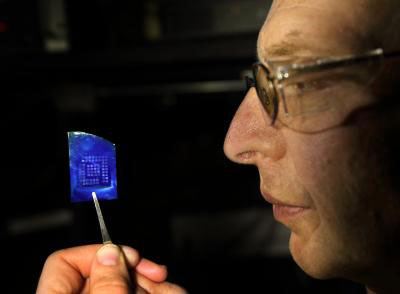 Sandia National Laboratories researchers have devised a novel way to realize electrical conductivity in metal-organic framework (MOF) materials, a development that could have profound implications for the future of electronics, sensors, energy conversion and energy storage.
Sandia National Laboratories researchers have devised a novel way to realize electrical conductivity in metal-organic framework (MOF) materials, a development that could have profound implications for the future of electronics, sensors, energy conversion and energy storage.
Dec 9th, 2013
Read moreEPFL researchers have developed a method for accurately determining the toxicity of nanomaterials. By using optical techniques, they are able to measure the concentration of the oxidizing substances produced by a damaged cell. Furthermore, this research also offers a new way to know more about the mechanisms of oxidative stress.
Dec 9th, 2013
Read more Researchers have discovered a new, potentially life-saving application for polyethylene terephthalate (PET), which is widely used to make plastic bottles. They have successfully converted PET into a non-toxic biocompatible material with superior fungal killing properties.
Researchers have discovered a new, potentially life-saving application for polyethylene terephthalate (PET), which is widely used to make plastic bottles. They have successfully converted PET into a non-toxic biocompatible material with superior fungal killing properties.
Dec 9th, 2013
Read moreResearchers are one step closer to an eye drop-free reality with the development of a drug-eluting contact lens designed for prolonged delivery of latanoprost, a common drug used for the treatment of glaucoma, the leading cause of irreversible blindness worldwide.
Dec 9th, 2013
Read moreThe energy needed to change the magnetic orientation of a single atom - which determines its magnetic stability and therefore its usefulness in a variety of future device applications - can be modified by varying the atom's electrical coupling to nearby metals.
Dec 8th, 2013
Read more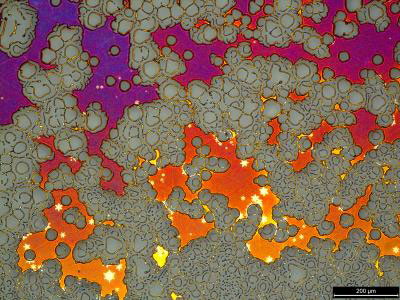 Huge grains of copper promote better graphene growth.
Huge grains of copper promote better graphene growth.
Dec 6th, 2013
Read more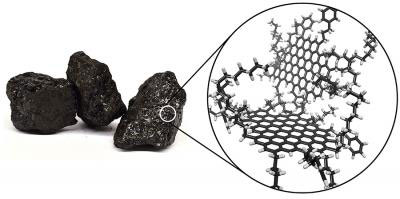 Scientists find simple method for producing dots in bulk from coal, coke.
Scientists find simple method for producing dots in bulk from coal, coke.
Dec 6th, 2013
Read more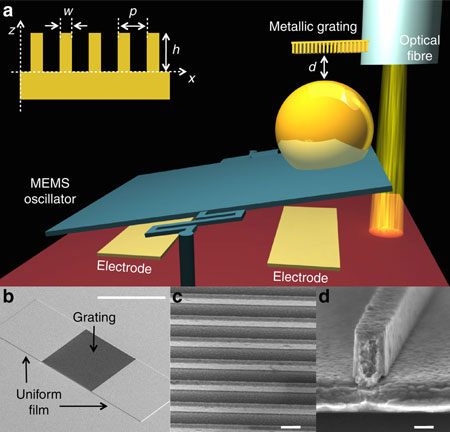 By nanostructuring one of two interacting metal surfaces at scales below the plasma wavelength, a new regime in the Casimir force was observed by researchers.
By nanostructuring one of two interacting metal surfaces at scales below the plasma wavelength, a new regime in the Casimir force was observed by researchers.
Dec 6th, 2013
Read more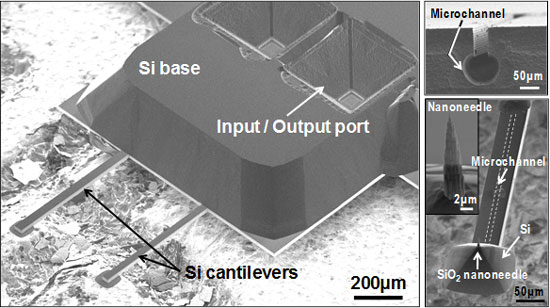 An innovative probe for atomic force microscope (AFM) that is integrated with a sharp-tipped hollow silicon dioxide (SiO2) nanoneedle instead of a conventional solid tip.
An innovative probe for atomic force microscope (AFM) that is integrated with a sharp-tipped hollow silicon dioxide (SiO2) nanoneedle instead of a conventional solid tip.
Dec 6th, 2013
Read more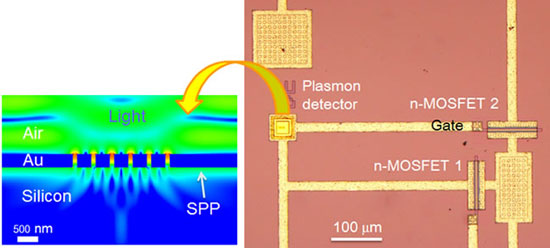 Many researchers are developing photonic devices employing surface plasmon polaritons for applications to photonic integrated circuits.
Many researchers are developing photonic devices employing surface plasmon polaritons for applications to photonic integrated circuits.
Dec 6th, 2013
Read more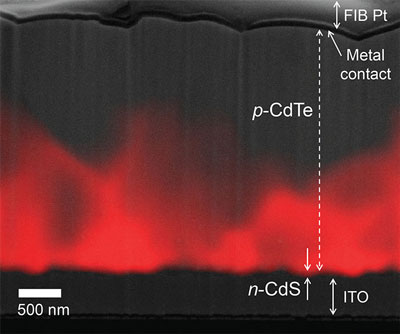 Researchers have demonstrated a new low energy electron beam technique and used it to probe the nanoscale electronic properties of grain boundaries and grain interiors in cadmium telluride (CdTe) solar cells. Their results suggest that controlling material properties near the grain boundaries could provide a path for increasing the efficiency of such solar cells.
Researchers have demonstrated a new low energy electron beam technique and used it to probe the nanoscale electronic properties of grain boundaries and grain interiors in cadmium telluride (CdTe) solar cells. Their results suggest that controlling material properties near the grain boundaries could provide a path for increasing the efficiency of such solar cells.
Dec 6th, 2013
Read more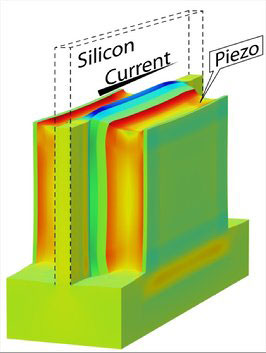 If silicon is squeezed, this affects the freedom of movement of the electrons in this material. This can promote or restrict the flow of electrical current. Compare it to a garden hose. When you stand on it, less water comes out. But strangely enough, the flow of electrons in silicon actually increases when the material is compressed.
If silicon is squeezed, this affects the freedom of movement of the electrons in this material. This can promote or restrict the flow of electrical current. Compare it to a garden hose. When you stand on it, less water comes out. But strangely enough, the flow of electrons in silicon actually increases when the material is compressed.
Dec 6th, 2013
Read more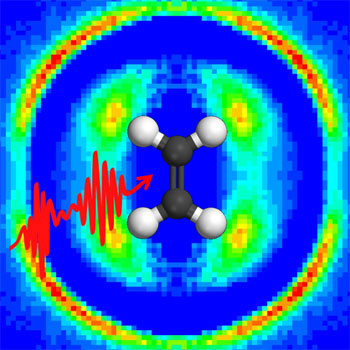 International team of scientists develops new feedback method for optimizing the laser pulse shapes used in the control of chemical reactions.
International team of scientists develops new feedback method for optimizing the laser pulse shapes used in the control of chemical reactions.
Dec 6th, 2013
Read more